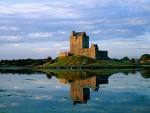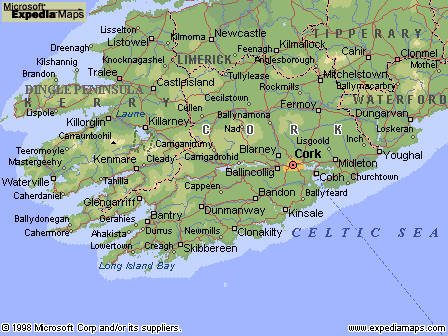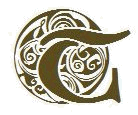
Click image to read the ancient McAuliffe clan legends, in story, and in the verses by Edward Walsh, the Poet of Duhallow

Links to Irish history and culture, genealogy, Irish interest sites
Leave a message or read messages from others seeking clan information, searching for relatives, etc.

The webmaster would appreciate being advised of any broken links you find while viewing any of these pages
Hit counter restarted 10 June 2006


If you haven't already done so, please take a moment or two to sign the Guestbook?





Won't you please take a moment or two to sign the Guestbook?
on the McAuliffe Discussion Forum
Where the webmaster offers opinions on matters affecting the clan


Don't like the music? Turn
it off here or play it again
The openiing tune is
'The Minstrel Boy'
This and most other midi tunes
on this site were sequenced by Barry Taylor
























While Saint Patrick is credited with driving the snakes out of Ireland, the fact is that there were none there to drive out., at least not in the last 1.8 million years. Some sources beleve the story may have been a symbolic reference to pagans, who had a serpent as their emblem.
Check this fun card!

Irish castles worth visiting. Click image to see list


Site designed and maintained by Bob McAuliffe, Greymouth, New Zealand. This page last updated 31 January 2008
An Irish Quote
"The contest on our side is not one of rivalry or vengeance, but of endurance. It is not those who can inflict the most, but those who can suffer the most who will conquer".
Inaugural speech of Cork Mayor Terence MacSwiney who died on hunger strike, October 25, 1920.






So I don't have any yet, but when I do I'll have somewhere to put them.







Much of the material fort this page has come from D.H Allen, 'The McAuliffes of Clanawley", 1991.
"Here frowned the dark
turrets in lordly pride;
Here smiled the gay chieftain's
hall.
The clansmen here marshall'd in
order wide;
When war-fires blazed on
the mountain's side,
For battle at glory's call."
he emergence of the MacAuliffes as a separate clan came at about the same time as the beginning of English colonisation in Ireland; invasions occured on a recurrent basis over the following centuries, culminating in the middle of the 17th century with land
confiscations on a large scale. Much of Ireland's history over these centuries is the story of Irish resistance to and rebellion against English rule.
The records show that most of the conflicts involving the MacAuliffes in the earlier centuries were battles with their neighbours. Later, however, they were to become involved in some of the most fierce resistance to English rule, and the consequences would change them forever.
Local Conflicts
For a long time after about 1400 A.D. not much is to be found in Irish records concerning the MacAuliffes. Some records which do exist refer to the uneasy relationship which existed between the MacAuliffes and their neighbours, especially the Fitzgeralds.
A passage from the Miscellaneous Irish Annals records that
"In A.D.1398 Amhlaoibh Bodhar, MacAmhlaoibh Eala, was killed at Claonglais, as he was going to the house of James, Earl of Desmond."
This tells us that Auliffe the Deaf, then chieftain of the MacAuliffes, was killed at Clonish, County Limerick, as he was on his way to pay his respects to James, the Earl of Desmond. Over a long period the two neighbours, MacAuliffe and the Earl of Desmond, had an 'on again, off again' relationship, varying between alliance and war. It would seem that at this time, 1398, the MacAuliffes recognised some sort of allegiance to the Earl. Clonish, in the Barony of Upper Conello, was ruled by the Lord of Clonish, a chieftain of a minor branch of the FitzGerald whose lands bounded those of the MacAuliffes in the mountainous region of the Cork-Limerick border. The slaying of MacAuliffe resulted in an ongoing feud between the two clans which finally resulted in a pitched battle between them more than a hundred years later. That event is recorded in the Annals of the Four Masters which records that (in 1535)
"MacAuliffe gained a great battle, in which were slain the lord of Clonish, and Fitzgibbon and a great array of the Sheehy clan. In the beginning of the conflict Maolmuire mac Briaine MacSweeney, MacAuliffe's constable, was slain."
(The Annals of the Four Masters is one the most important sources of early Church history and Irish genealogy. It was compiled in the 17th century by four friars from the Franciscan friary near Donegal Town ).
This conflict was of a local nature with a minor branch of the FitzGeralds and seemingly did not affect the good relationship the MacAuliffes had at that time with the Earl of Desmond. Cattle- raiding was a frequent occurrence in those days and a cause of friction between neighbouring clans. The battle referred to here was probably the result of one of these raids, but was clearly on a large scale to have merited such a mention in the Annals.

Strategic Position of Clanawley
Clanawley was the northern outpost of MacCarthy country and a very strategic one at that. In times of conflict the MacAuliffes maintained observation posts near the tops of the Mullaghareirk Mountains. From there they had a sweeping view of the barony of Duhallow, a large portion of the Cork/Limerick borderland, the Golden Vale as far as Limerick City, the River Shannon to the north, the hills of west Limerick and the Kerry plain. Most of that sweep of country, with the exception of Duhallow, was ruled by the Earl of Desmond, chief of the Fitzgeralds, who had expansionist aims and occasionally came into conflict with the MacCarthys and, because of their strategic position, the MacAuliffes.
At other times, it seems, the clans of Duhallow also entered into some sort of alliance with the Earl of Desmond. The Fitzgeralds, one of the 'Geraldines' who had arrived with the Normans, were by now thoroughly Irish; they spoke the Irish language, they were patrons of of the poets, scholars and musicians and, most importantly, they were staunch supporters of the Catholic faith. Pressure from the English was causing the clan system to fall apart and old loyalties were changing. The MacDonagh MacCarthys, the MacAuliffes, the O'Callaghans and the O'Keeffes helped Gerald, the last Earl of Desmond, when in 1665, he was defeated by the Butlers at the battle of Affane, in County Waterford.
This relief map by Microsoft shows the strategic position of Clanawley, which is shown roughly contained within the red circle on the map. Clanawley's upper boundary in the Mullaghareirk Mountains on the Cork-Limerick border (top of the circle) overlooks lower country in many directions.

MacSweeney was a gallowglass, a kind of professional soldier. As MacAuliffe's commander, he was in charge of the defences of Castle MacAuliffe, training of the men for war, and leading them into battle. Although in this conflict MacAuliffe emerged victorious, MacSweeney's death would have been a great loss.

16th century depiction of a cattle raid.





























